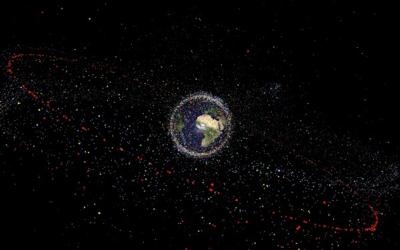Fri, Apr 19, 2013
Experts Gathering Next Week In Germany
The continuing growth in space debris poses an increasing threat to economically vital orbital regions. Next week, hundreds of top experts from across the globe will meet at Europe’s largest-ever debris forum to share their latest research findings and discuss potential solutions. Satellite operators worldwide, including those flying telecom, weather, navigation, broadcast and climate-monitoring missions, are now focusing their efforts on controlling space debris.

All human-made objects now in space result from the near-5000 launches by all spacefaring nations since the start of the space age. Around two thirds of catalogued objects originate from orbital break-ups – more than 240 explosions – and fewer than 10 known collisions. The 2009 collision between America’s Iridium-33 civil communications satellite and Russia’s Kosmos-2251 military satellite destroyed both and created a large amount of debris – more than 2200 tracked fragments. Scientists estimate the level of space debris orbiting Earth to be around 29 000 objects larger than 10 cm, 670 000 pieces larger than 1 cm, and more than 170 million above 1 mm. “Any of these objects can harm an operational spacecraft,” says Heiner Klinkrad, Head of ESA’s Space Debris Office.
Heiner explains that satellites collisions with fragments larger than 10 cm would be catastrophic, releasing hazardous debris clouds that can cause further catastrophic collisions that may lead to increasing debris in some orbits. “Space debris mitigation measures, if properly implemented by satellite designers and mission operators, can curtail the growth rate of the debris population. Active debris removal, however, has been shown to be necessary to reverse the debris increase,” he said.
The ultimate goal is to prevent collisional cascading from setting in over the next few decades. “As this is a global task, active removal is a challenge that should be undertaken by joint efforts in cooperation with the world’s space agencies and industry,” says Thomas Reiter, Director of Human Spaceflight and Operations. “ESA, as a space technology and operations agency, has identified the development of active removal technologies as a strategic goal.”
The 6th European Conference on Space Debris will be held at ESOC, ESA’s European Space Operations Centre, Darmstadt, Germany, April 22–25 . During four days, the conference will present and discuss the latest results, define future directions of research, and look at active debris removal. More than 300 researchers, engineers, policy-makers, space law specialists, insurance underwriters, space and ground system operators, and institutional organisations such as the EU and the UN are expected to attend.
(Image of space debris provided by ESA)
More News
Its Offerings Are Lighter, Cleaner, and Now Pushing Past 1,000nm on SAF Jet Fuel DeltaHawk’s diesel-powered aircraft lineup has seen incredible upgrades over the last few yea>[...]
The Airplane Experienced A Total Loss Of Engine Power On December 3, 2025, about 1600 central standard time, a Mooney Aircraft Corp. M20K, N57229, was substantially damaged when it>[...]
Make Sure You NEVER Miss A New Story From Aero-News Network Do you ever feel like you never see posts from a certain person or page on Facebook or Instagram? Here’s how you c>[...]
Aero Linx: European Society of Aerospace Medicine (ESAM) As a pan-European, independent forum, it works to promote the safety and health of all persons involved in aviation and spa>[...]
“We are excited to see Wisk achieve this milestone, and I’m so proud of the team that made it possible. The team at Wisk has built advanced technologies across flight c>[...]
 Aero-TV: DeltaHawks Diesel Power Steps Into the Spotlight
Aero-TV: DeltaHawks Diesel Power Steps Into the Spotlight NTSB Prelim: Mooney Aircraft Corp. M20K
NTSB Prelim: Mooney Aircraft Corp. M20K ANN FAQ: Turn On Post Notifications
ANN FAQ: Turn On Post Notifications ANN's Daily Aero-Linx (12.20.25)
ANN's Daily Aero-Linx (12.20.25) Aero-News: Quote of the Day (12.20.25)
Aero-News: Quote of the Day (12.20.25)



